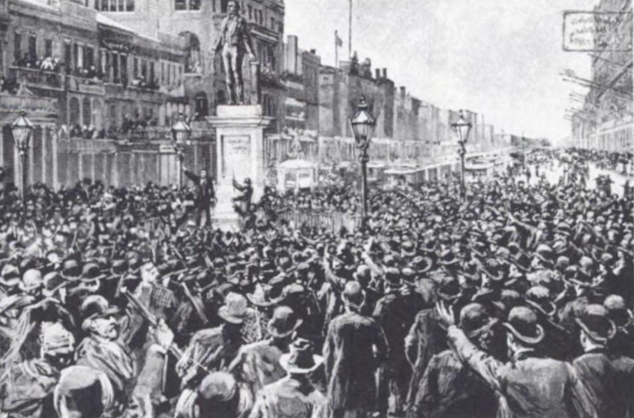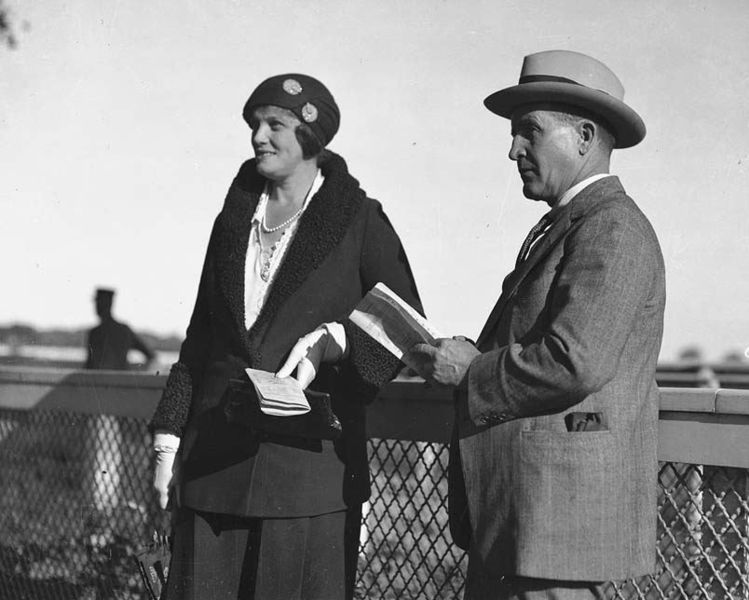There are two theories about the infamous mass lynchings of (alleged) mafiosi in New Orleans in 1891: One, an enraged populace rose up against Mafia criminality, which was real and running roughshod over the law; two, the attack was triggered by the most heinous, bigoted feelings and actually encouraged by the power structure of the day.
Just a week after the lynching the Saturday Review stated, “it is at least possible that some hatred of very industrious and successful competitors in business mingled with the more respectable zeal of the lynching party.” Neither theory is airtight. Although there was some desire to undermine the growing economic power of local Italian Americans, only the most rabid of the “there-ain’t-no-mafia-school” could deny the criminal society’s presence in New Orleans.
New Orleans probably was the most anti-Italian city of the era, and its mayor, Joseph A. Shakespeare, was one of the most anti-Italian politicians of his time. A letter from his office castigated Southern Italians and Sicilians as “ ... the most idle, vicious and worthless people among us .... Except the Poles we know of no other nationality which is [as] objectionable as a people.”
  |
But turn-of-the-century New Orleans was filled not only with venal politicians and police on-thetake, but also with many Italian criminals. It was the Italian immigrants who jammed the New Orleans ghettos, which, like any other ghetto, spewed out criminals. Undoubtedly, many Italian criminals of the period were not mafiosi, but it must be conceded that New Orleans represented one of the main ports of entry for mafiosi into the United States, probably rivaling New York.
It is difficult to pinpoint the first appearance of the Mafia in America but it was probably in New Orleans during the late 1800s. Between 1888 and 1890 the New Orleans Mafia (made up of disparate groups as was the case in Sicily) committed an estimated 40 murders without serious opposition.
During this period, Antonio and Carlo (or Charley) Matranga, two Honored Society members from Palermo, Sicily, took control of the Mississippi River docks. Tribute had to be paid to them before a freighter could be unloaded. However, the Matranga operations were challenged by the Provenzano brothers, leaders of another Mafia group. War broke out between the two groups, and killing along the docks became a regular occurrence.
The police failed to stop the battling until the flamboyant chief of police, David Peter Hennessey, personally took over. Soon the Matrangas found themselves hassled at every turn while the Provenzanos were left virtually unbothered. The Matrangas sent warning to the chief but the pressure continued. So they tried to bribe him, only to have him reject their offer.
This convinced the Matrangas that the Provenzanos had offered him more and that Hennessey was determined to have a piece of the riverfront rackets for himself. So they fell back to an old Sicilian custom of killing the government official who got in their way. They did not understand the ramifications that would follow the killing of an American police chief.
Hennessey wrote his epitaph when police, conducting a routine murder investigation, charged two Provenzano brothers with complicity in the murder of a Matranga gangster whose head had been sliced off and stuffed in a fireplace. The Matrangas, determined to kill off the Provenzanos, hired some of the city’s foremost lawyers to aid the prosecution. Then Chief Hennessey came to the rescue.
He told the press he had uncovered the existence of a criminal society, the Mafia, in the city and would offer proof during the Provenzanos’ trial. On October 15, 1890, Hennessey left his office for home. He was cut down by a shotgun blast a half-block from his house. Hennessey managed to direct some shots at a number of his fleeing assailants and when asked who had shot him, he whispered “Dagoes” and collapsed.
The murder outraged the citizens of New Orleans who liked Hennessey, despite many unsavory elements in his police record with the city and despite the likelihood that he might be on the take. A grand jury was convened and announced that “the existence of a secret organization known as the Mafia has been established beyond doubt.” Nineteen men described as Mafia members were indicted as principals and conspirators in the Hennessey murder, but the trial was perceived by most people as a farce.
A large number of the 60 potential witnesses were threatened, intimidated or bribed, and several members of the jury were later found to have taken bribes as well. Despite what was regarded as overwhelming evidence against at least 11 of the defendants, all but three were acquitted, and the jury could not reach a verdict on these three.
All the defendants were returned to the parish prison to await final disposition of their case and then released. There can be little doubt there was considerable elation and celebration of the jury verdict in the Italian section of the city, which inflamed public opinion. (Some observers maintain that the celebrations in the Italian quarter were solely festivities for the birthday of King Umberto I of Italy, but it is ludicrous to believe that a people as discriminated against as the Italians would not celebrate the acquittal of their countrymen. If they had not, the Italians would have been strikingly different from any other national or racial group under similar circumstances.)
What followed was a blot on New Orleans. Two days after the trial’s surprise ending, a great number of mass meetings and other protests fanned by outright bigotry were held. Ultimately, a mob of several thousands, headed by 60 leading citizens, marched on the jail. They had a death list composed of the 11 defendants against whom the evidence was the strongest. Left off the list were those defendants against whom the evidence was weakest, including the Matranga brothers.
Two of the mafiosi were pulled screaming to the street and hanged from lampposts. Seven others were executed by firing squads in the jail yard, and two more were riddled with bullets as they hid in a doghouse built for the jail’s guard dog. Prominent in the lynch mob were a goodly number of blacks, giving the lynching a unique dimension in the American South.
While some newspapers denounced the hangings, the citizens and especially the business community seemed rather pleased by what had been done. A new song, “Hennessey Avenged,” by a popular poet named Fred Bessel became a best-seller. For a time the lynchings threatened international complications. Italy recalled its ambassador, severed diplomatic relations with the United States and demanded reparations and punishment for the lynchers. Eventually, the affair was settled with Washington paying $25,000 to the dead men’s relatives in Italy.
The lynchings did not kill the Mafia in New Orleans, although newspapers announced, “The Mafia Exterminated.” However, the affair did make an impression on mafiosi. Charley Matranga, who was to pick up the leadership of the mafiosi in New Orleans and rule until the early 1920s, managed to stay in the background thereafter and issue orders that were carried out by front men. And when Lucky Luciano formed the national crime syndicate, a basic rule was enunciated that under no circumstances was a police officer to be murdered.




























